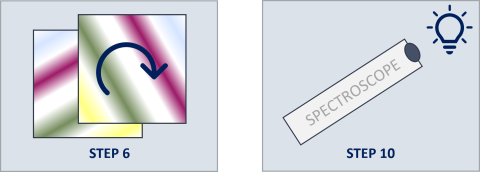Spectroscopy involves splitting light into its different wavelengths. Each chemical element emits or absorbs a unique spectrum of light. It is a bit like a barcode or a fingerprint. This makes spectroscopy a useful tool for measuring the chemical composition of objects in space.
In this activity, you will make and use a spectroscope. This is a tool used by astronomers to do spectroscopy. Light from a source enters the spectroscope and is broken up into its different wavelengths. The spectroscope you will be making in this activity uses a diffraction grating to break up the light. This is a thin piece of plastic film that contains thousands of tiny slits or gratings. These gaps in the material are too small to be seen by the human eye.
When you look into the spectroscope you will see different colours. This is the result of different wavelengths of light scattering at different angles as they pass through the grating paper. Different wavelengths correspond to different colours of light. This will give you a background which looks like a rainbow. On top of this rainbow, you might see dark lines, where there is a lack of light, or strong coloured lines, where there is a lot of light. These are due to the abundance of chemical elements between you can the light source.
By the end of this activity you will:
- have made your own spectroscope
- have used your knowledge about how light behaves
- understand more about how spectroscopy can be used in astronomy
To complete this activity you will need:
- printed spectroscope cut-out (printed card works much better than paper)
- diffraction grating paper (this can be purchased from online retailers)
- a light source to look at (e.g., a lamp or a torch)
- scissors
- ruler
- sticky tape


